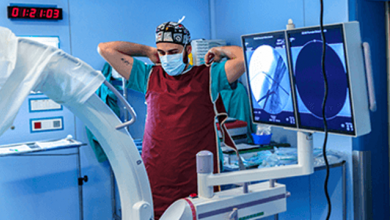Search results
Paul Roberts
Author
Author(s):
Deepak Padmanabhan
,
Sandeep Shankar
,
Avinash Chandrashekharaiah
,
et al
Added:
3 years ago
Ionizing radiation is a workplace hazard that goes undetected. In the cardiac catheterization laboratory, where various interventional and electrophysiological procedures are done, physicians and other staff are exposed to ionizing radiation daily. The amount of radiation exposure in the catheterization laboratory is exponentially more compared to other departments using X-ray and fluoroscopy,…
View more
Author(s):
Mathew S Maurer
Added:
3 years ago
Cardiac output (CO) is a fundamental measure for the assessment of cardiac performance and is applied widely to detect the presence of cardiovascular disease and monitor its progression, as well as to monitor patients in challenging hemodynamic circumstances and to optimize therapy. CO is a key parameter in characterizing a patient’s hemodynamic state. For example, a notable characteristic of…
View more
Author(s):
Ana Mola
,
Carmen Perez-Terzic
,
Randal Thomas
,
et al
Added:
3 years ago
The changing population landscape in the US has impacted the many levels of the US healthcare system. It is estimated that, by 2050, minority populations together will comprise approximately 50% of the total population.1 This demographic shift has prompted policy makers, scientists, researchers, educators, and healthcare providers to draft a series of national health initiatives to define,…
View more
Author(s):
Tasneem Z Naqvi
Added:
3 years ago
Congestive heart failure (CHF) is the number one hospital discharge diagnosis for older adults and the leading cause of hospital readmissions, reflecting poor quality of life for patients and increased healthcare resource use, and is the cause of 300,000 deaths annually.1 Cardiac resynchronization therapy (CRT) has become a new effective treatment modality in those with drug-resistant advanced…
View more
Author(s):
Jagmeet P Singh
Added:
3 years ago
Cardiac resynchronization therapy (CRT) has achieved widespread approval as a safe and efficient therapeutic strategy for medically refractory congestive heart failure (CHF). The standard indications for CRT include patients with advanced heart failure and evidence of systolic dysfunction (ejection fraction [EF] ≤35%), conduction tissue disease (QRS duration ≥120ms), and marked cardiac symptoms …
View more
Author(s):
Soraya M Samii
,
Javier E Banchs
Added:
3 years ago
Abstract
The concept of using an implantable device to manage arrhythmias and heart failure started over 50 years ago. Since then, we have seen these devices improve patient outcomes from bradyarrhythmias, atrial fibrillation, ventricular arrhythmias, and heart failure. These devices are now standard of care in the management of patients and include pacemakers, implantable cardioverter…
View more
Author(s):
Soraya M Samii
,
Javier E Banchs
Added:
3 years ago
The use of implantable devices to treat arrhythmias started with the implantable pacemaker back in the late 1950s. The risks and costs of implantation limited the indications for the procedure initially. A similar pattern was seen with the initial implantable cardioverter-defibrillators (ICDs) in the early 1980s. In the late 1990s, technology of both these devices focused on the management of…
View more
Author(s):
Henry M Spotnitz
,
T Alexander Quinn
Added:
3 years ago
Surgeons have contributed studies of the pathophysiology and treatment of arrhythmias in experimental animals and patients during thoracotomy. This research has involved epicardial1 and endocardial2 pacemakers and implantable cardioverter–defibrillators (ICDs).3 Surgeons helped to define the mechanisms and ablation methods for supraventricular arrhythmias (including Wolff-Parkinson-White syndrome…
View more
Author(s):
Matthew J Budoff
Added:
3 years ago
Cardiac computed tomography (CT) has evolved greatly over the last 20 years. This article reviews its current clinical uses, and describes some of the potential for even greater utility in the near future. Electron beam tomography (EBT) was developed 20 years ago specifically for cardiac imaging. Although the technique can quantify ventricular anatomy and function1 as well as myocardial…
View more











